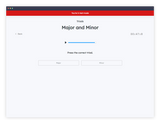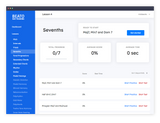The Ear Training Program
A complete and systematic approach to improving your relative pitch
Beato Ear Training Method
Presenting the Beato Ear Training Method. A totally unique, first of its kind methodology utilizing interactive, aural modules, guaranteed to improve your relative pitch, making you a stronger musician in every way. For those with perfect pitch, its use can expand the range and scope of identifying multiple levels of sonorities, deepening the immediate apprehension of vertical and linear harmonic complexity.

Systematically improve your hearing
The program focuses on harmonic, intervallic and rhythmic ear training to help dramatically improve your ear in every area.
Become an Ear Training Jedi
Learn how to play a song in one listening. The concepts taught in this program are unique and first of its kind.
Practice mode vs. Test mode
Use the practice mode to to play unlimited randomized examples until you feel confident and then start testing.
Community
Get access to the exclusive Beato Ear Training Community Board and discuss practice tips, ask questions or suggest new features.
World-Wide Leaderboard
Choose to take part in the world-wide ear training leaderboard and see how you stack up against other players, or whether you are the world-best in a particular category - or keep your scores private.
Constantly updating
We're constantly adding new perks and features based on your input! If you'd like to see something, let us know and we'll make sure to include them in the next versions!
All lessons Included:
Pitch
Timbre Comparison
Musical Aptitude
Intervals
Harmonic: Seconds
Harmonic: Thirds
Harmonic: Fourths and Fifths
Harmonic: Sixths
Harmonic: Sevenths
Melodic: Seconds
Melodic: Thirds
Melodic: Fourths and Fifths
Melodic: Sevenths
Harmonic: Tritones and Major Sevenths
All Intervals
Triads
Major and Minor
Major Triad Inversions
Minor Triad Inversions
Diminished and Augmented
Diminished Triad Inversions
Basic Triads
Sus2 and Phrygian
Sus4 and Lydian
Advanced Triads
All Triads
Bonus: Sus4b5 and Locrian
Seventh Chords
Maj7, Min7 and Dom 7
Half dim7, Dim7
Phrygian Maj7 and Maj7sus2
Maj7sus4 and Lydian Maj7
Dom7sus4, Lydian Dom, Phrygian Dom
Dim Maj7 and Aug Maj7, Min Maj7
All 7th Chords
Tonal Progressions
Progressions #1
Progressions #2
Progressions #3
Permutation Trainer: The "4 chords"
Permutation Trainer: Imaj7 - iimin7 - IVmaj7 - V7
Secondary Chords
V of ii and V of iii
V of IV and V of V
V of vi and V of iii
All Secondary Dominant Chords
vii of ii and vii of iii
vii of IV and vii of V
vii of vi and vii of iii
All Secondary Seventh Chords
Extended Chords
Major add2 and Major add4
Minor add9 and Minor add11
Phrygian Major and Lydian Major
Phrygian Minor and Lydian Minor
Major6 and Major addb6
Minor6 and Minor addb6
Major9, Major7#11 and Major13
Minor9, Minor11 and Minor13
MinMaj9, MinMaj11 and MinMaj13
All Added-Note Triads
Rhythm
1 Note - Quarters
2 Notes - Quarters
3 Notes - Quarters
4 Notes - Quarters
Any # of Notes - Quarters
4 Notes - Eights
Any # of Notes - Eights
4 Notes - Sixteenths
Any # of Notes - Sixteenths
Modal Voicings
Phrygian and Locrian
Mixolydian and Ionian
Dorian b2 and Altered Dominant
Melodic Minor and Locrian Natural 2
Mixolydian #11 and Mixolydian b6
Lydian Augmented and Lydian
Harmonic Minor and Phrygian Major
Ionian Augmented and Lydian #9
Locrian Natural 6 and Dorian #4
Altered Dominant bb7 and Altered Dominant
All Major Modal Voicings
All Melodic Minor Modal Voicings
All Harmonic Minor Modal Voicings
Scales
Scale Trainer: Major Modes
Scale Trainer: Melodic Minor Modes
Scale Trainer: Harmonic Minor Modes
Scale Trainer: Pentatonic, Blues and Bebop
Scale Trainer: Symmetric Scales
Ionian and Lydian
Dorian and Aeolian
Phrygian and Locrian
Mixolydian and Mixolydian#11
Melodic Minor and Locrian Natural 2
Dorian b2 and Altered Dominant
Mixolydian #11 and Mixolydian b6
Lydian Augmented and Lydian
Major Pentatonic and Major Blues
Harmonic Minor and Phrygian Major
Ionian Augmented and Lydian #9
Locrian Natural 6 and Dorian #4
Altered Dominant bb7 and Altered Dominant
Half Whole and Whole Half
Whole Tone vs Augmented
Minor Pentatonic and Minor Blues
Minor Bebop and Melodic Minor Bebop
Major Bebop and Dominant Bebop
Modal Harmony
Modal Triads #1 - Major Tonic
Modal Triads #2 - Major Tonic
Modal Triads #3 - Major Tonic
Modal Triads #4 - Major Tonic
All Modal Triads - Major Tonic
Modal Triads #1 - Minor Tonic
Modal Triads #2 - Minor Tonic
Modal Triads #3 - Minor Tonic
Modal Triads #4 - Minor Tonic
All Modal Triads - Minor Tonic
Bitonal Harmony
Major Triads: Basic
Major Triads: Intermediate
Major Triads: Advanced
Major Triads: All
Minor Triads: Basic
Minor Triads: Intermediate
Minor Triads: Advanced
Minor Triads: All
Reharmonization
Standard Reharms #1
Standard Reharms #2
Standard Reharms #3
Standard Reharms #4
Standard Reharms #5
Inner Note Hearing
Perfect Fifth Shell
Flat Sixth Shell
Major Sixth Shell
Flat Seventh Shell
Major Seventh Shell
Twelve Tone Harmony
Pentatonic Single Octave
Diatonic Single Octave
Chromatic Single Octave
Pentatonic Multi Octave
Diatonic Multi Octave
Chromatic Multi Octave

How did this start?
In 2010, I discovered that my son Dylan had Perfect Pitch. As we explored this ability, I realized that by combining the use of nomenclature derived from music theory with aural recognition practice, I could dramatically improve his Relative Pitch abilities as well. These skills are the bedrock, essential tools for advanced fluency in improvisation and composition. I taught ear training and advanced music theory
As a college professor in the late 80's / early 90's, I used what were then (and still are) considered unorthodox methods toward an all-inclusive, unified ear training coupled with advanced theoretical knowledge. For example, identifying Bitonal, Polytonal and Modal Voicings and their accompanying scales for improvisational use.
This Beato Ear Training method is the only method building higher-order musical fluency by developing neural networks in both the receptive and active modes of aural apprehension, increasing understanding of the unique syntax and grammar of harmony. In the process, each domain reinforces and lifts the other, toward a truly unified, higher order apprehension and appreciation of Music in all forms.
Frequently Asked Questions
-
Is it a membership or one-time purchase?
It's a one-time purchase.
-
Is this the full version?
Yes, you are buying the full version. This early access version contains the first 10 chapters and once the rest of the chapters are released, you will get them free of charge.
-
What does the program consist of?
It consists of over one-hundred interactive ear training software modules, along with training and explanation videos and supplementary documents.
-
Which topics are covered?
The chapters that are available so far are the following:
Section 1: Pitch
Section 2: Intervals
Section 3: Triads
Section 4: Sevenths
Section 5: Tonal Progressions
Section 6: Secondary Chords
Section 7: Extended Chords
Section 8: Rhythm
Section 9: Scales
Section 10: Modal Voicings
For a detailed list of lessons click here: Lessons
-
What are the remaining chapters that will be added?
Here they are:
Section 11: Melodic Dictation
Section 15: Polyrhythm
Section 16: Odd Meter
Section 18: Twelve Tone Harmony
Section 20: Clusters
-
I have perfect pitch - will this help me?
Yes! It will help you develop your relative pitch which is critical for harmonic identification and much more.
-
Will I be able to hear like Dylan?
If you practice this enough to the point at which you can achieve a 100% score consistently on each lesson, you will be able to do what he does from a relative pitch point of view.
-
What devices can this be used on?
For best results, use it on a desktop or laptop. It currently works on some smartphones and tablets, but full support will be added soon.
-
Is this too difficult for me?
No! It starts from the very beginning with the most basic form of ear training there is: Decide which note of two notes is higher.
After that it goes into intervals, triads, then seventh chords, rhythm and more advanced topics.
Contact Form
Send us a message and we will get back to you within 24 hours.









